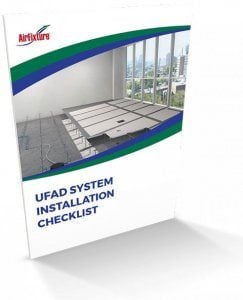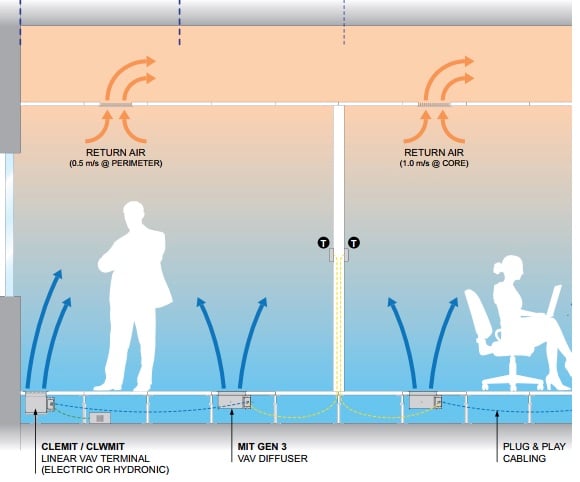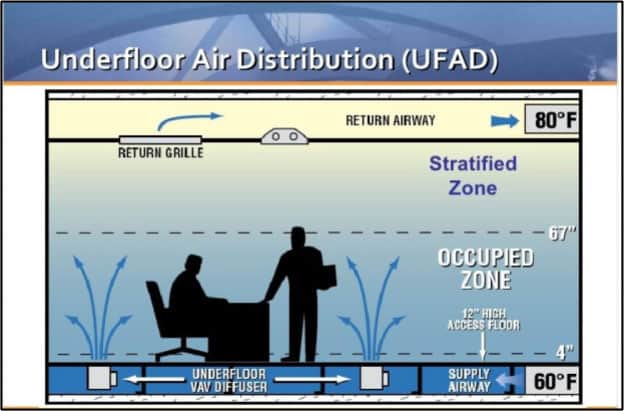What Every Architect Needs to Know About UFAD
Architects and building designers face difficult decisions when developing a design for a new or retrofitted building. From ceiling heights to...
Floor, wall and ceiling mounted to meet your unique project design.

Raised flooring has become an increasingly popular option for commercial and government spaces over the years. From data centers utilizing the style to easily move power and data cabling under the floor to offices of all kinds using it for layout flexibility, raised flooring is an adaptive solution for many industries. However, it is important to install these systems correctly with proper support - including a properly installed underfloor air distribution (UFAD) system.
UFAD is an air distribution system strategy that provides ventilation and space conditioning in buildings. The system uses a pressurized supply space, or plenum, between the structural concrete slab of the foundation and the raised access flooring (RAF). This supplies conditioned air through air diffusers installed in the RAF directly into the occupied space of the building.
UFAD systems allow higher thermostat setpoints compared to the traditional overhead systems, providing more thermal stratification. Other benefits of using a UFAD system include layout flexibility, improved thermal comfort, better ventilation and energy efficiency, and reduced costs. However, the efficiency of a UFAD system relies heavily on it being set up properly, including ensuring it is appropriately sealed.
Sealing your UFAD system is integral to ensuring it is running correctly and efficiently. A leak anywhere in your underfloor plenum can cause major malfunctions in the system and lead to bigger problems in the future. There are two types of leakage that can occur in a UFAD system. The first is leakage into the space itself. This kind of leak won’t negatively affect the energy level because air is still getting to the zone it is intended to cool. However, the second kind of leak - a leakage into the pathways that bypass the space - can lead to increased fan energy as the system tries to maintain constant pressure. This will result in difficulty maintaining occupied space comfort, which in turn leads to inefficient energy usage and increased operating costs
Careful consideration for air leakage must be taken when installing any UFAD system. Below are a few tips and best practices for ensuring your system is well-sealed and functioning at maximum efficiency.
Before installing your UFAD system, there are two crucial steps that must be taken in order to ensure the system functions properly and air flow isn’t compromised. The first step needs to happen even before the raised access floor installation has begun, and primarily focuses on laying down the ducts and sealing them properly.
Once all ducts have been laid and properly sealed, it’s time to have your RAF installed. Before doing so, it’s important to do a proper inspection of all the relevant components. Check ducts for leakage, look for major blockages, check the wiring, etc. You want to do a thorough inspection in order to avoid causing an even bigger mistake in the future.
Once the RAF is installed, it’s time to check that the system is working properly and that there are no issues with the floors and/or walls.
After sealing, do another inspection to make sure you didn’t miss anything. Ensure there’s no air in the walls, be sure that the gaps between floor panels are kept at a minimum, and check the floor pressure.
Want some more tips on installing and caring for a UFAD system? Download our UFAD System Installation Checklist. It’ll walk you through the process to ensure you aren’t making any critical mistakes that will cost you in the long run.

Architects and building designers face difficult decisions when developing a design for a new or retrofitted building. From ceiling heights to...
Underfloor air distribution (UFAD) continues to gain popularity among building and facility owners due to the range of benefits it offers versus a...

There has been a remarkable rise in the number of new building projects which have or plan to use a raised access floor (RAF) and underfloor air...